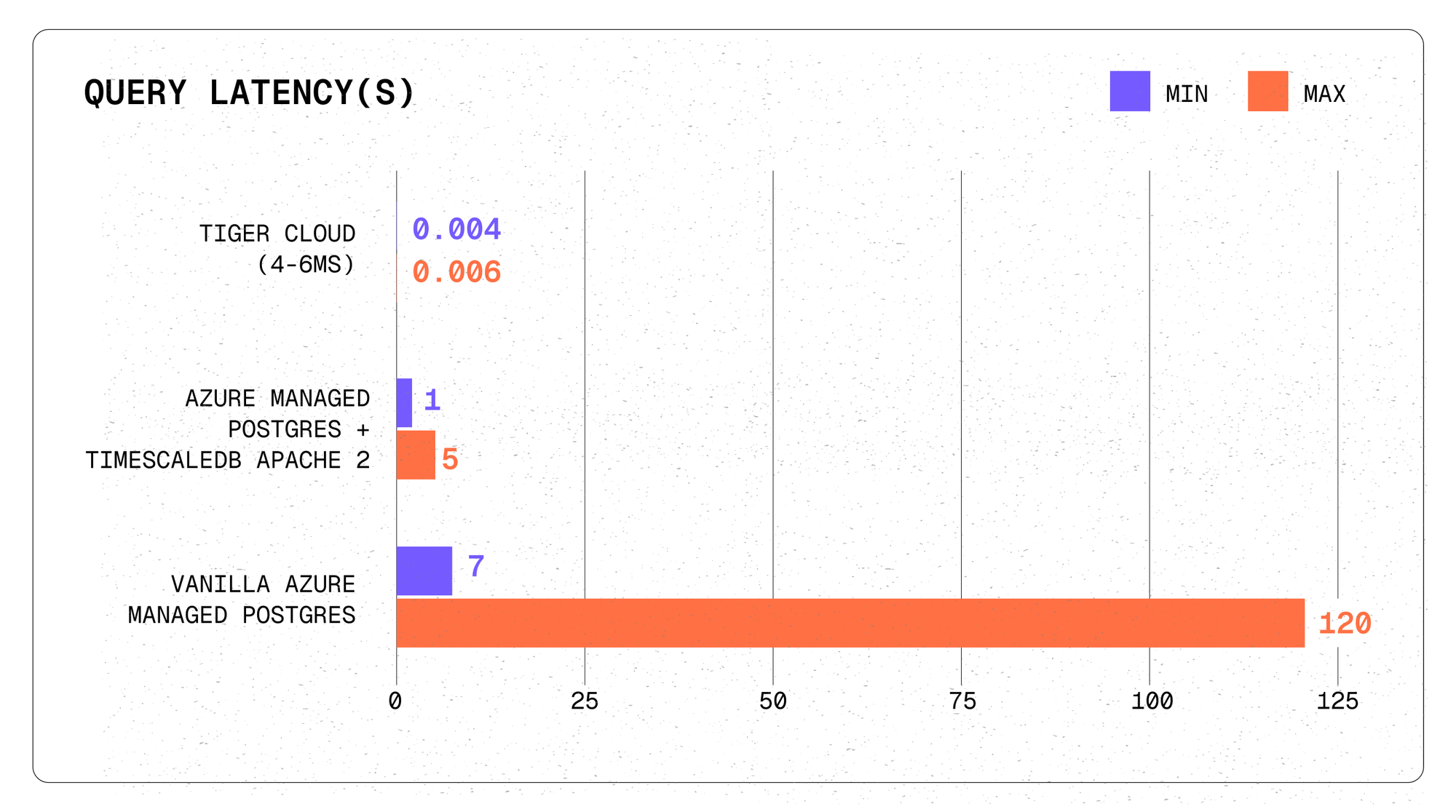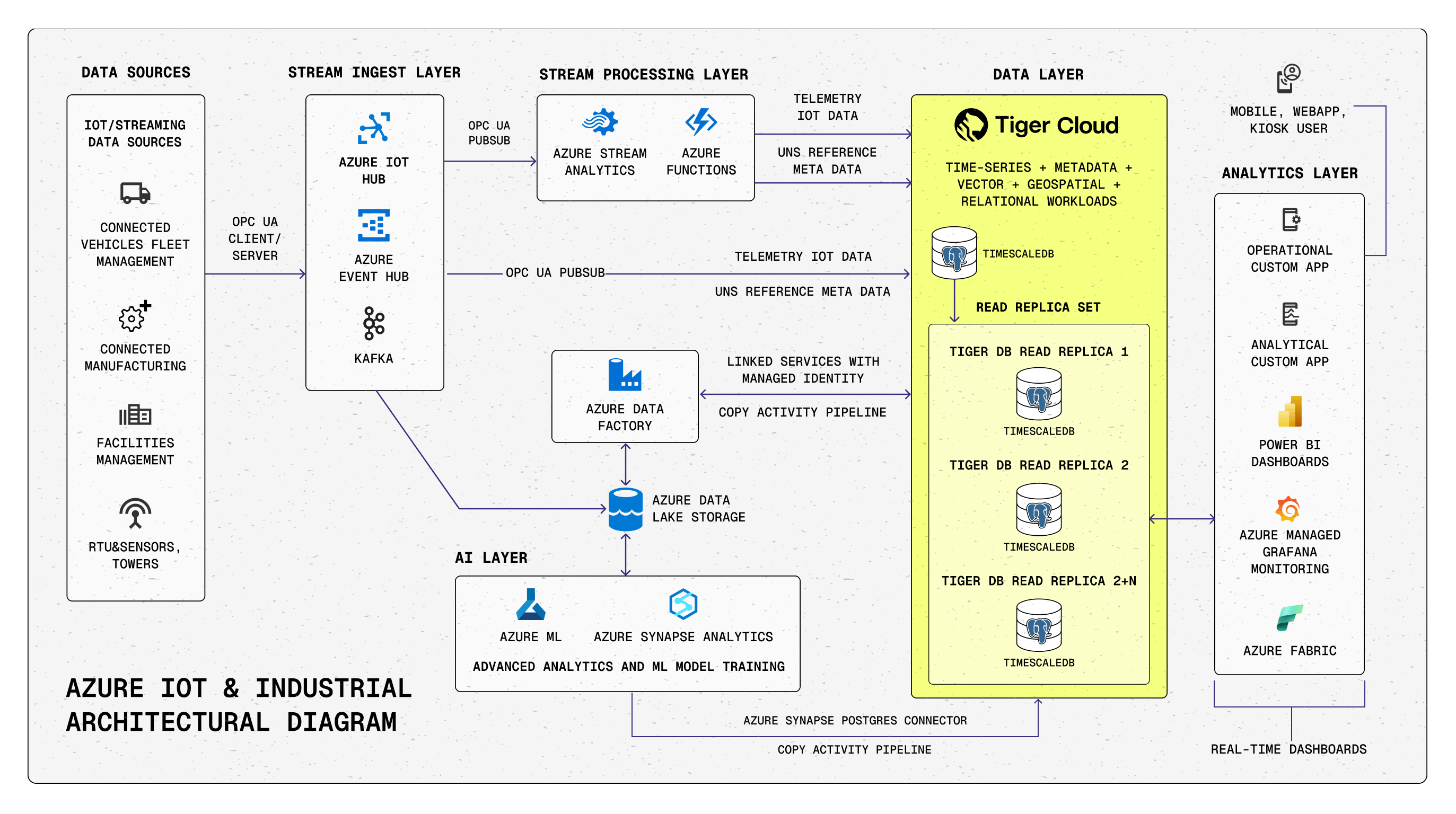Category: All posts
Nov 18, 2025

Azure developers have pushed Postgres past its natural limits for years. As time-series workloads grow, dashboards slow down, pipelines multiply, and storage becomes harder to manage. The TimescaleDB included with Azure Database for PostgreSQL works for early projects, but it only includes the Apache 2 Edition that lacks the advanced capabilities required for modern scalable time-series workloads.
Teams often face a difficult choice. They either move their time-series workloads into a specialized engine and accept more architectural complexity or stay on Postgres and watch performance degrade as data volumes increase.
Today, there is a better option.
Tiger Cloud on Azure is now generally available in Azure Marketplace. It brings the full, modern TimescaleDB feature set to Azure as a fully managed service. You keep the Postgres interface and SQL your team already uses. You stay inside your Azure environment. You remove all the limitations that have slowed you down.
When we say this is the full TimescaleDB experience on Azure, we mean the version that lets you stay entirely in PostgreSQL instead of offloading workloads into ADX or rewriting queries in KQL just to keep dashboards responsive. You see real performance improvements immediately.
You also gain the complete TimescaleDB feature set, including hypercore columnar storage for fast analytics, incremental continuous aggregates for real-time rollups, and hyperfunctions for advanced statistics, interpolation, time-weighted operations, and built-in performance tuning.
For Azure developers, this is the time-series database you have been waiting for.
If you run time-series or operational analytics on Azure today, these challenges will feel familiar.
Split stacks. You keep transactions in Postgres. You keep analytics in ADX. You connect them with pipelines that require constant maintenance.
Slow dashboards. Queries that ran well at 10 GB turn sluggish at 1 TB.
High storage costs. You prune aggressively or pay to store data you rarely access.
A limited TimescaleDB edition. The Apache 2 Edition lacks row and columnar storage, native compression, and incremental continuous aggregates.
The result is an unfavorable tradeoff. You can have fast analytics with more complexity or a simple Postgres stack that slows down as your data grows. Tiger Cloud on Azure removes this compromise.
Azure users can now deploy the complete TimescaleDB feature set without leaving Postgres or the Azure ecosystem. Everything is delivered as a fully managed service with unified billing through Azure Marketplace. It is a direct path to real-time performance on the database foundation Azure teams already trust.
Tiger Cloud on Azure is available in East US 2 in Virginia and West Europe in Amsterdam. We will expand to additional regions based on demand.
For teams using Azure Database for PostgreSQL with TimescaleDB (Apache 2 Edition), this is a straightforward upgrade. You keep the SQL interface while gaining modern storage, full compression, incremental rollups, hyperfunctions, and production-grade operational features without needing to self-host.
“We rely on Azure for our infrastructure and compliance needs,” said Samuli Kortelainen, CTO at SimAnalytics, a manufacturing analytics company. “With Tiger Cloud on Azure, we’ll finally get full time-series functionality while keeping all data within our Microsoft environment.”
Most teams notice three changes right away.
We validated Tiger Cloud on Azure using RTA Bench, an open-source benchmark for real-time analytics on Postgres, and compared it with Azure Database for PostgreSQL with and without the Apache 2 Edition.
The results were clear.
The largest improvements appeared in workloads that combine recent and historical data, run wide scans across long time ranges, or filter across high-cardinality dimensions.

You can find the full methodology and test configurations in an upcoming Azure Benchmark Blog.
Tiger Cloud integrates into existing Azure environments without requiring major changes. The goal is straightforward: it should feel like a better Postgres, not a new platform.

Here is how it fits into the flow of your systems.
Your data sources stay the same. Industrial sensors, PLCs, SCADA systems, MES and ERP platforms, and OPC UA streams continue without modification.
Your ingest layer continues to run as it does today. Azure IoT Hub, Event Hubs, and Kafka all work as they do now. If you want fewer moving parts, you can subscribe directly from Event Hubs into Tiger Cloud.
Your stream processing tools remain unchanged. Azure Stream Analytics and Azure Functions enrich and normalize incoming events. Hot paths route into Tiger Cloud for real-time workloads, and cold paths continue into your lakehouse.
Tiger Cloud becomes your operational data layer. Hot and historical data live together in one place. Queries return in less than 10 milliseconds on typical workloads. Compression keeps storage costs practical.
Analytics and ML tools continue to connect with standard Postgres drivers. Power BI, Synapse, Azure ML, and notebooks all work as they do today. Read replicas support heavier BI and ML queries. High availability and point-in-time recovery keep the service reliable.
If you currently support these capabilities with a mix of services and a regular Postgres instance, Tiger Cloud replaces the most fragile parts of your architecture.
Tiger Cloud on Azure gives you the full performance, scale, and efficiency of modern TimescaleDB without leaving PostgreSQL or the Azure ecosystem. If your dashboards, alerts, or ML models depend on fast access to fresh and historical data, this is the simplest way to run time-series workloads at scale while keeping the architecture your team already knows.
Ready to get started? Signup for a free trial at tigerdata.com. Then you can either enter your credit card directly (or get invoice billing if needed) via your Tiger Cloud console.
Alternatively, if you want to pay through the Azure Marketplace, select from two options: Pay-As-You-Go and Annual Commit.
Pay-As-You-Go. Launch directly from Azure Marketplace and pay only for the compute and storage you use. This option is ideal for teams that want to evaluate real workloads without a long procurement cycle.
Annual Commit or Private Offer. Work with the Tiger Data team to design the right topology and secure custom terms through a private offer. This path is best for organizations moving larger or long-term workloads and want predictable pricing within their Azure invoice.
No new query languages. No specialized engines. No pipelines to maintain. Just real-time performance on the Postgres foundation you already trust, delivered as a fully managed service inside Azure.
Start with Tiger Cloud on Azure and run time-series workloads the way they were meant to run on Postgres. Fast, efficient, and ready for production today.